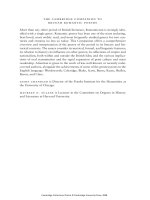The cambridge companion to british roman 54
Bạn đang xem bản rút gọn của tài liệu. Xem và tải ngay bản đầy đủ của tài liệu tại đây (39.58 KB, 1 trang )
j e f f r e y n . c ox
11 On “The Literary Diary; or, Improved Common-Place-Book” (Bristol Central
Library), used by Reynolds, his sister Charlotte, Frances Hood, and Thomas Hood
to collect poetry, among other writings, see Paul Kaufman, “The Reynolds-Hood
Commonplace Book: A Fresh Appraisal,” Keats-Shelley Journal 10 (1961),
pp. 43–52; for other such gatherings made within the extended Keats circle,
see Clayton E. Hudnall, “John Hamilton Reynolds, James Rice, and Benjamin
Bailey in the Leigh Browne-Lockyer Collection,” Keats-Shelley Journal 19 (1970),
pp. 11–37. On writers and reviewers, see Barbara M. Benedict, “Readers, Writers,
Reviewers, and the Professionalization of Literature,” in The Cambridge
Companion to English Literature 1740–1830, ed. Thomas Keymer and Jon
Mee (Cambridge: Cambridge University Press, 2004), pp. 3–23; Marilyn Butler,
“Culture’s Medium: The Role of the Review,” in Curran, The Cambridge Companion to British Romanticism, pp. 120–47; British Romanticism and the Edinburgh Review, ed. Massimiliano Demata and Duncan Wu (New York: Palgrave
Macmillan, 2002); and Mark Parker, Literary Magazines and British Romanticism (Cambridge: Cambridge University Press, 2001).
12 Among the many studies of canon formation in this period, see John Guillory,
Cultural Capital: The Problem of Literary Canon Formation (Chicago: University of Chicago Press, 1993); Michael Gamer, Romanticism and the Gothic
(Cambridge: Cambridge University Press, 2000); Robert Crawford, Devolving
English Literature (Oxford: Clarendon Press, 1992); David Simpson, “Romanticism, Criticism and Theory,” in Curran, The Cambridge Companion to British
Romanticism, pp. 1–24; and Natalie M. Houston, “Anthologies and the Making
of the Poetic Canon,” in A Companion to Victorian Poetry, ed. Richard Cronin,
Alison Chapman, and Antony H. Harrison (Oxford: Blackwell Publishing, 2002),
pp. 361–77.
13 St. Clair, The Reading Nation, pp. 660–4.
14 Stephen Gill, William Wordsworth: A Life (Oxford: Clarendon Press, 1989),
pp. 330–7, 344.
15 On Wordsworth’s efforts to create himself as the key poet of the day, see
Lee Erickson, “The Egoism of Authorship: Wordsworth’s Poetic Career,” in
The Economy of Literary Form: English Literature and the Industrialization
of Publishing, 1800–1850 (Baltimore: Johns Hopkins University Press, 1996),
pp. 19–48.
16 Elizabeth Barrett, The Battle of Marathon (London: printed for W. Lindsell,
1820), p. 3.
17 See Michael Scrivener, Poetry and Reform: Periodical Verse and the English
Democratic Press 1792–1824 (Detroit: Wayne State University Press, 1992);
Anne Janowitz, Lyric and Labour in the Romantic Tradition (Cambridge: Cambridge University Press, 1998); and Paul Thomas Murphy, Towards a WorkingClass Canon: Literary Criticism in British Working-Class Periodicals, 1816–1858
(Columbus: Ohio University Press, 1994).
18 Jeffrey C. Robinson, Unfettering Poetry: The Fancy in British Romanticism (New
York: Palgrave Macmillan, 2006), p. 226. Subsequent references in the text.
19 Margaret J. M. Ezell, Writing Women’s Literary History (Baltimore: Johns
Hopkins University Press, 1993), pp. 66–131.
20 Francis Hodgson, Sæculomastix; or, The Lash of the Age We Live In; A Poem, in
Two Parts (London: Porter, 1819).
32
Cambridge Collections Online © Cambridge University Press, 2008









